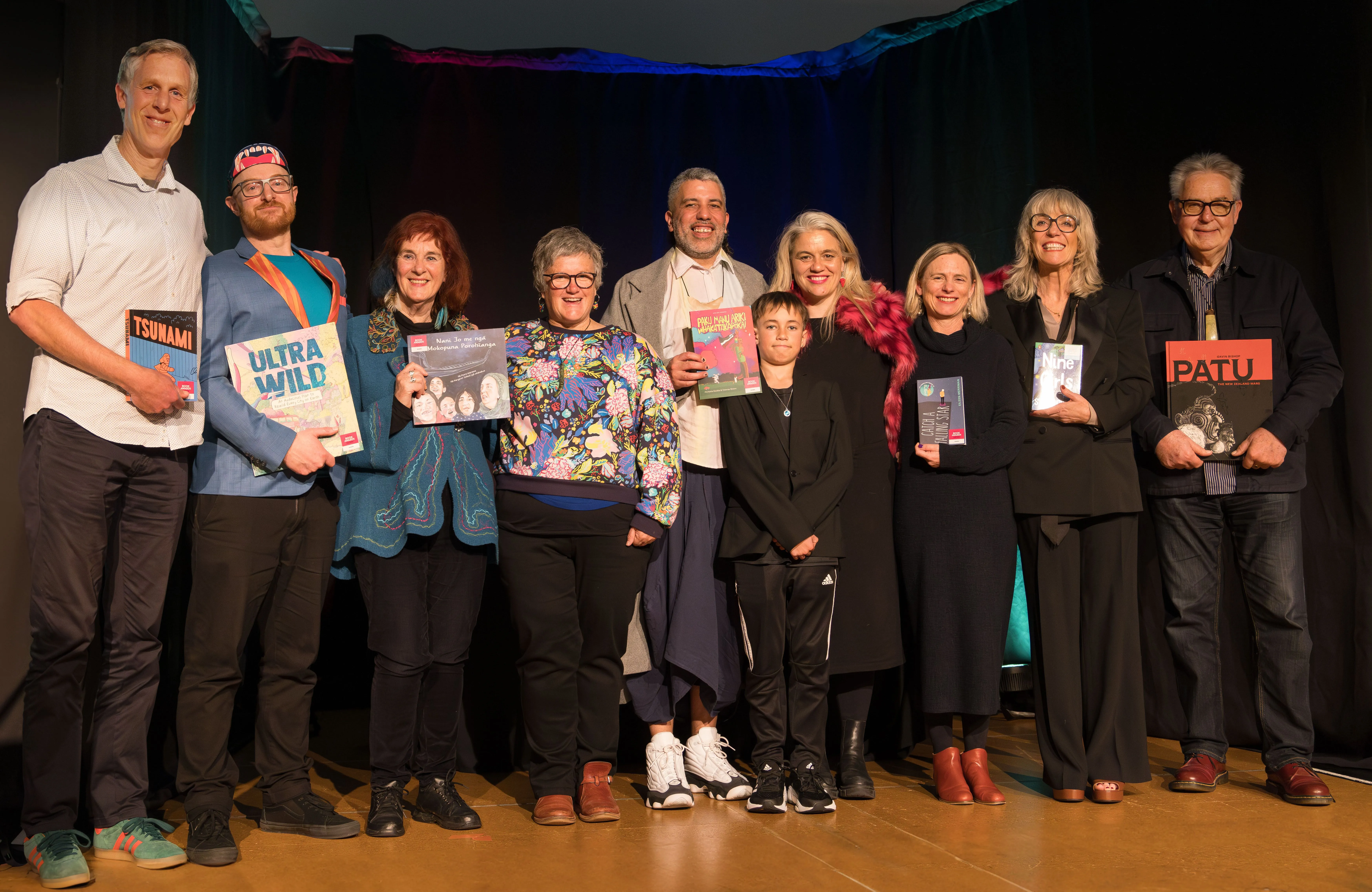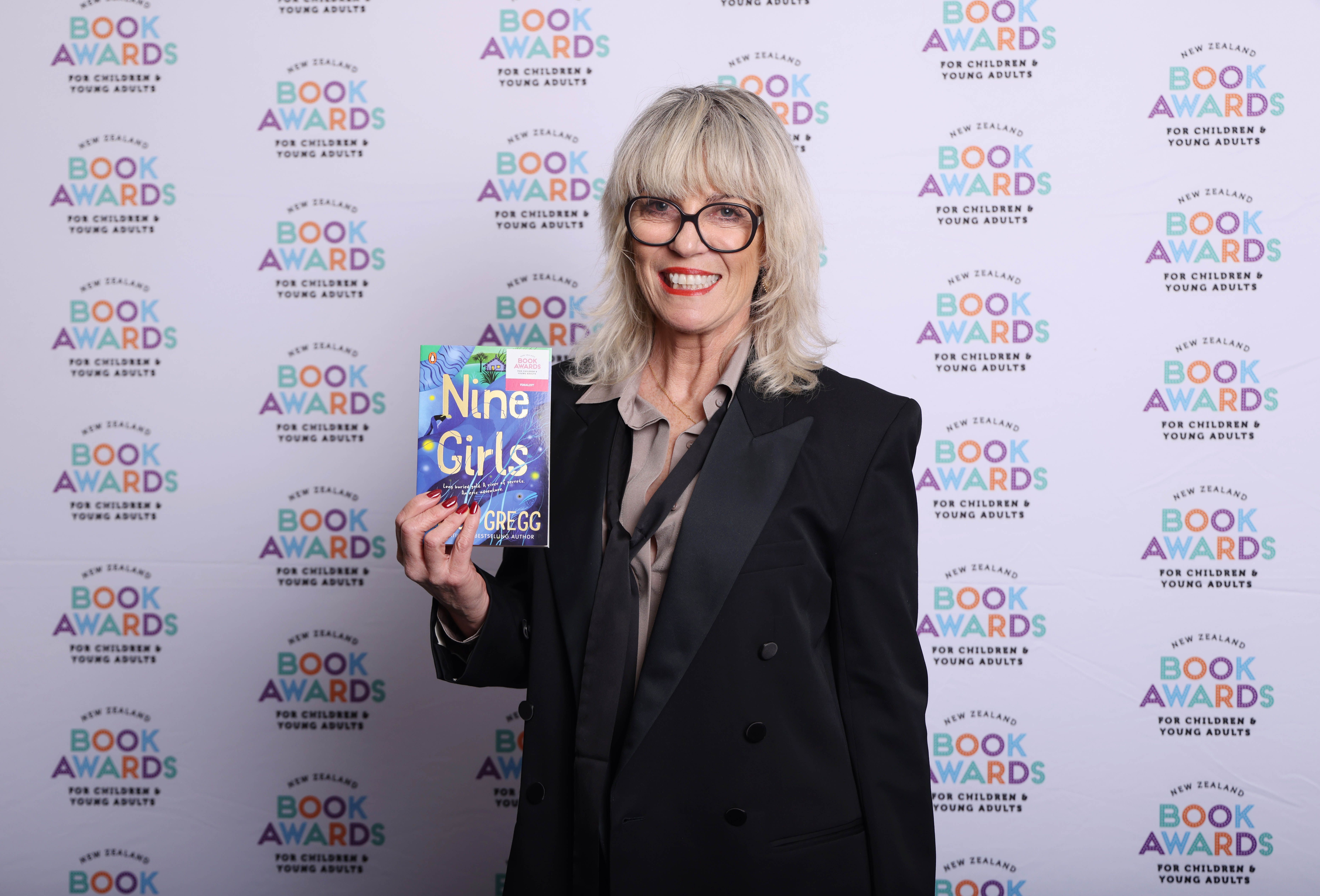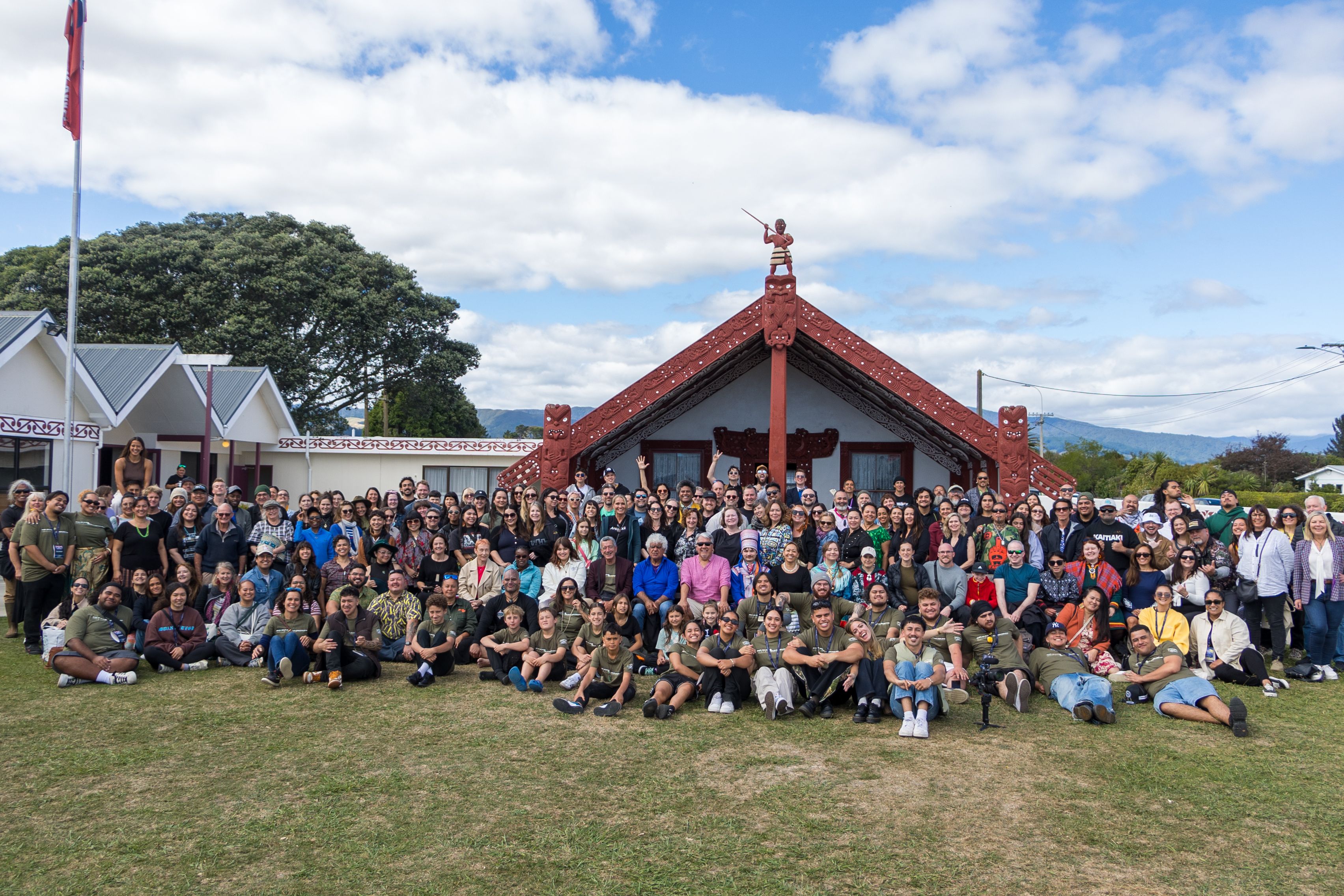Lowdown: Awards Success & International Opportunity for NZ Creatives
A week to remember for a litany of Aotearoa artists, big opportunities opening up for many more, key appointments and NZ's link to one of the world's most beloved cartoon franchises.

To see your name up in lights alongside Margaret Mahy is as big a comparison as a New Zealand writer could hope for.
Stacy Gregg will have woken up with that extraordinary feeling after winning the top award at the New Zealand Book Awards for Children and Young Adults in Wellington on Wednesday night (14 August).
It was one of two awards that Gregg (Ngāti Mahuta, Ngāti Pūkeko, Ngāti Maru Hauraki) collected on the night for her novel Nine Girls. The bestselling author's latest work blends comedy, fantasy and history together, and has been praised by the judging panel as “a taonga from a masterful storyteller.”
Gregg left Pipitea Marae with both the Margaret Mahy Book of the Year gong and the Wright Family Foundation Esther Glen Award for Junior Fiction, as well as an overall $17,000 boost to her bank balance.
Gregg told The Lowdown "The Margaret Mahy Award couldn’t have come at a better time for Nine Girls. I’m currently partnering with Pōneke-based writer Dana Leaming, working on an animated feature film adaptation of the book for Kurawaka/Ama studios."
Gregg is no stranger to success - her popular pony series has sold millions of copies worldwide - but Nine Girls is the first time she’s explored te ao Māori, with the coming-of-age tale drawn from her own childhood in Ngāruawāhia.
"Our aim is to create the first truly Te Ao Māori animated movie and this award, for all of us, is the fist bump that could make all the difference."
2024 convenor of judges, Maia Bennett details “After careful deliberation, both judging panels came to a unanimous decision on a book that not only exemplifies the highest standards, but that we believe will make a lasting contribution to Aotearoa’s national literature for children and young adults; and as such, deserves the accolade of supreme winner.”

“Vivid and well-developed characters populate a fast-paced, eventful narrative as we follow the young protagonist’s journey to discovering her Māori identity. Te ao Pākehā and te ao Māori are equally uplifted as the text explores our bicultural history,” the judges explained.
Six other categories crowned winners on the night - one in particular a long time coming.
Eileen Merriman's been a bridesmaid in the Young Adult Fiction Award on multiple occasions - but her novel Catch a Falling Star could not be denied, securing her the $8,500 price and earning the judges respect for "the remarkably authentic portrayal of the complicated and endearing teenage protagonist’s escalating mental health problems."
Merriman told The Lowdown "Finally winning the Young Adult Fiction prize after being short-listed so many other times was unexpected... and wonderful! I am so pleased that this book won, as it is so close to my heart, having had close family members affected by debilitating mental illness."
At the other end of the award spectrum, no one has cleaned up at these particular awards more than Gavin Bishop (Tainui, Ngāti Awa) - and he added to his staggering list of accolades with the Russell Clark Award for Illustration with d Patu: The New Zealand Wars.
The Picture Book Award went to Paku Manu Ariki Whakatakapōkai by Michaela Keeble, which was written with her son Kerehi Grace (Ngāti Toa Rangatira, Ngāti Porou) and illustrated by Tokerau Brown. Described as a sophisticated picture book which can be enjoyed by all ages, the judges found it to be groundbreaking, deeply creative and completely original.
Ultrawild: An Audacious Plan to Rewild Every City on Earth by Steve Mushin was named the Elsie Locke Award for Non-Fiction winner, while the Wright Family Foundation Te Kura Pounamu Award went to Nani Jo me ngā Mokopuna Porohīanga, written by Moira Wairama and illustrated by Margaret Tolland.
And the future of children's literature was acknowledged with the NZSA Best First Book Award - which was claimed by Ned Wenlock for Tsunami, a graphic novel that was highlighted for its sophisticated understanding of the comic form. It tells an often-disturbing story of a troubled and bullied boy with skill and a complexity that trusts readers to meet the book's challenges.
On his win in the $2,500 award, Wenlock told The Lowdown "This is my first foray into the messy, complex, surprising and often frustrating act of putting pen to paper and writing/drawing long-form fiction. So to have Tsunami nationally recognised with this award is incredibly encouraging."
The awards doesn't just pat authors on the back, it practices what it preaches - following a mission to foster literacy and a love of reading among New Zealand’s tamariki and rangatahi.
In the build-up to the award, a Books Alive event for Invercargill school children saw finalist authors and illustrators bring the magic of books to life, while WORD Christchurch hosted a selection of finalist authors who entertained primary and intermediate school students at Haeata Community Campus in Ōtautahi and hundreds of Wellington students converged on the National Library of New Zealand Te Puna Mātauranga o Aotearoa and Te Whare Pukapuka o Waitohi in Johnsonville as 20 finalists provided behind-the-book talks, workshops on writing and illustration, lightning talk sessions, storytelling, and live drawing.
Māoriland gets a share of $1.2M spoils

One of the most consistent advocates for Indigenous filmmaking in Aotearoa has found another way to guide the next generation in the right direction.
Māoriland Indigenous Co-Lab has been selected to receive funding from the New Zealand Film Commission’s (NZFC) $1,200,000 Industry-Led Talent Development Fund.
It will see five Māori film projects supported to develop and pitch on a global stage, in what is being described as "an ambitious year-long program to support Māori filmmakers to achieve excellence in feature film production".
Organisers say the program will advance select projects to become market-ready, and of great appeal to investors and provide them with funding and international mentoring.
Māoriland Film Festival Director Madeleine de Young says “Māoriland exists to celebrate Indigenous storytelling through film. In the 11 years of the Māoriland Film Festival, we’ve seen the rise of Indigenous cinema, and we've supported both emerging and established filmmakers through programs like M.A.T.C.H Creative Intensifiers, the Ngā Pakiaka Incubator Program and the NATIVE Slam.
"What we've seen over this time is the power of international Indigenous collaboration to advance careers and deliver incredible films. The Māoriland Indigenous Co-Lab is our first feature film lab, and by engaging the relationships we've across the Indigenous world we'll support five Māori feature film projects to become finance and production-ready."
Applications are open now (click here for the details) until 6 September.
Splitting the $1.2M pot for this fund is A Wave in the Ocean (AWITO) 2 Deep Dive, a pop-up directors' intensive created by Dame Jane Campion and Philippa Campbell.
Six filmmakers will be selected for a full-time, 15-week distillation of the original AWITO workshop programme (that was backed by Netflix), followed by a 12-month period in which they are financed and mentored through the development and production of a short film.
“Building on the inspiration from the inaugural A Wave in the Ocean cohort, Deep Dive aims to make a profound and practical contribution to the lives and careers of highly motivated and talented New Zealand filmmakers." Dame Jane Campion.
Mason the main man

Staying with the NZFC - the winds of change continue with the confirmation of Graeme Mason as the organisation's new Chair. Well, winds of familiarity perhaps.
He was appointed by Arts Minister Paul Goldsmith who stated “Graeme brings a wealth of leadership skills as well as local and international industry experience that will be invaluable to the role. He has been the chief executive of Screen Australia for a decade, previously chief executive of NZFC itself for over four years, and has more than 30 years of international experience in film, television, and multimedia businesses.
“Graeme has supported creatives to reach local and global audiences throughout his career working with large studios in the US, a UK television network, independent producers, and government agencies.
“I would like to thank his predecessor Alastair Carruthers for his services on the board and for sharing his extensive governance and sector knowledge with the organisation.”
NZFC CEO Annie Murray added that the appointment was "great news for the Commission and the New Zealand film industry. As an industry veteran he brings with him decades of wisdom and experience to an organisation he is more than familiar with.”
Mass-ey success

Who lives in a pineapple under the sea?
If you didn't know the answer to this (and maybe have it play out in song, broken down in syllables), then you've been living under a rock.
Spongebob Squarepants is one of the biggest animated franchises on the planet and loved for decades. Every it touches is a success - and the latest chapter has a huge element of Aotearoa involved.
Netflix's Saving Bikini Bottom: The Sandy Cheeks Movie is absorbing young (and old) fans around the planet - it had 12.8 million views in the first week in the United States alone - and they're listening to a soundtrack made on our shores, buy Kiwi artists.
Welliington's Massey Studios on the university’s Pukeahu campus was the location, with the original score composed by The Phoenix Foundation members Sam Flynn-Scott, Conrad Wedde and Luke Buda (collectively credited as Moniker, and features vocals by award-winning singer/songwriter Tami Neilson and included The New Zealand Symphony Orchestra (NZSO).
Neilson wrote and co-produced songs for the film’s main character – the quick-witted squirrel Sandy. Tami wrote three songs and sings the classic Spongebob Squarepants theme song with a Sandy Cheeks twist.
The recording was organised by Music Supervisor Karyn Rachtman of Mind your Music (whose credits include Pulp Fiction, Clueless, Romeo + Juliet and Moulin Rouge!), with Massey involved in the initial conversations to form the scope of the project and the application for the funding to bring it to fruition.
Flynn-Scott explains the two-year process, utilising the world-class facilities.
“In animation you have to work to these unfinished sketched animatics, so you need to imagine the finished film. We wanted to be true to the freewheeling spirit of the original SpongeBob cartoon but also tap into the 80s kids' films we grew up with.
"There is no way we could have achieved that without working with a real orchestra. It was a huge project, but deeply rewarding.”
"We have also used the studio for pre-tour rehearsals and having students help out with monitors and set up is quite frankly an absolute game changer for old lazy dogs like us.
“Having the two control rooms is amazing for a project of this scale. We had Karyn Rachtman, our music supervisor, set up in one room, where we could discuss big-picture issues and just relax and enjoy the music. Then in the other control room we had our orchestrator Claire Cowan, our supervising conductor Brent Stewart and engineer Graham Kennedy. Their job was to focus in on every little detail and communicate in real time with the conductor Hamish Mckeitch.
“There isn’t a lot of time when you have a whole orchestra on the clock and 60 minutes of music to record, so having a studio of this scale is essential.”
If you're interested in the music but less in the cartoons - you can listen below.
Biennale bound

South Korea is in for a taste of Aotearoa art - with three New Zealand artists set to be exhibited at the Busan Biennale 2024 this month.
The always socially engaged and internationally driven Te Tuhi commissioned work (in partnership with the Busan Biennale Organising Committee) from a trio of creatives - Abigail Aroha Jensen, John Vea and Layne Waerea - which will be on display from 17 August until 20 October.
The exhibition - titled Seeing in the Dark and curated by Te Tehi's International Director Vera Mey and Philippe Pirotte, will feature 62 artists/teams from 36 countries and will be centred around the Busan Museum of Contemporary Art and the historic downtown area.
Kirikiriroa-based Māori visual artist Jensen is presenting Inside my papahou: puoro tuatini. Her site, Désirée - ā whakamātao owha - a new 8-channel sound installation that utilises field recordings from the Tokomaru Bay Freezing Works, an industrial ruin that bears witness to the economic growth and decline of the Tairāwhiti region.
The recordings are imagined as a sonic tukutuku (act of weaving back and forth), threading together sites of whakapapa and waiata. Jensen has used materials found within the surrounding environment, such as pipe and rubble, to echo the sound of taonga puoro, making lively the imperceptible histories embedded in the ruins.
University of Christchurch lecturer Vea is an artist who works with sculpture, video and performance art, with a focus on narratives of labour, migration and gentrification that exist within Te Moana Nui a Kiwa. His new performance, 96 degrees in the shade, will be presented as a video installation, exploring ideas of impermanence and itinerancy through the entanglement of labour and access to shelter.
The work sees Vea disassemble and reassemble a mobile shoe-shine kiosk under the partial shade of a post as it moves throughout the course of a working day. On a visit to Busan, the artist noticed the small footpath kiosks run by shoe- shiners, whose mobile units provide scarce shelter from the fearsome sun. 96 degrees in the shade acknowledges the often extreme conditions that labourers work in, and raises questions about the politics of shelter: who has access to shade, and what might this shade obscure?
A former lawyer now a part-time lecturer in law and visual art theory at AUT, Waerea's (Ngāti Wāhiao, Ngāti Kahungunu, Pākehā) practice involves carrying out performance art interventions that seek to question and challenge social and legal rules of preferred behaviour in the public sphere.
Her Biennale offering, Free Promises, explores the concept of social agreements or ‘promises’ as interpersonal practices governed by highly individual and spontaneous systems of values. Taking place at the Museum of Contemporary Art Busan, members of the public are invited to kōrero and enter into a reasonable ‘promise’ with the artist. This ‘promise’ could include carrying out a small action, saying something, or even an agreement not to do something.
Big opportunities for this trio of creatives to spread their wings internationally.